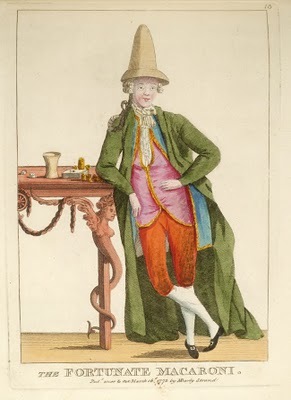MARY DARLY 1756-1779
Macaronis
The macaronis were an ephemeral phenomenon, as well as an extension of the fops and beaus of the earlier part of the century. They were called, among other epithets, ‘noxious vermin,’ ‘that doubtful gender,’ and ‘amphibious creatures,’ and were compared variously to monsters, devils, reptiles, women, monkeys, asses, and butterflies.
“Their concern for elaborate clothing, including tight trousers, large wigs, short coats, and small hats made them the ridicule of their generation, who focused on their gender ambiguity and the dangers of their conformity to foreign and effeminate fashion. A contemporary pamphlet, The Vauxhall Affray, sums up this view: ‘But Macaronies are a sex Which do philosophers perplex; Tho’ all the priests of Venus’s rites Agree they are Hermaphrodites. This gender ambiguity is the aspect of the representational life…’ (West, The Darly Macaroni Prints and the Politics of “Private Man.” Eighteenth-Century Life 25.2 [2001] pp.170-182).
“…the marks that had been codified into the macaroni type [were]: fine sprigged fabric, tight clothes, oversized sword, tasseled walking stick, delicate shoes, and, most recognizably, an enormous wig. This wig, combining a tall front with a fat queue or “club” of hair behind, was the feature that epitomized the macaroni’s extravagant artifice during London’s macaroni craze of the early 1770s. Named for the pasta dish that rich young Grand Tourists brought back from their sojourns in Rome, the macaroni was known in the 1760s as an elite figure marked by the cultivation of European travel. But as The Macaroni and Theatrical Magazine explained in its inaugural issue in 1772, ‘the word Macaroni then changed its meaning to that of a person who exceeded the ordinary bounds of fashion; and is now justly used as a term of reproach to all ranks of people, indifferently, who fall into this absurdity.’ Macaroni fashion was contagious, and as it spread beyond its original cadre into the rising…” (Rauser, Hair, Authenticity, and the Self-Made Macaroni.Eighteenth-Century Studies 38.1 [2004] pp. 101-117)
.
James Akin (1773-1846). The Pedlar and his Pack or the Desperate Effort, an Over Balance. Philadelphia, 1828. Etching and aquatint with hand coloring.